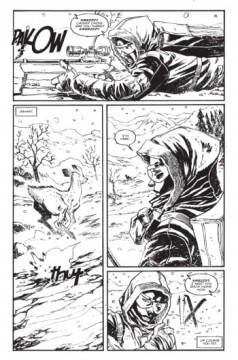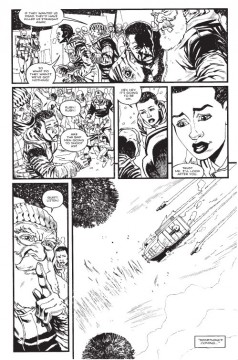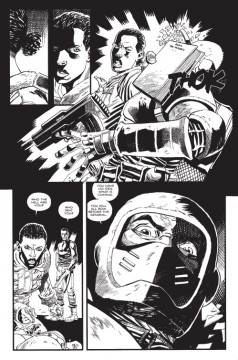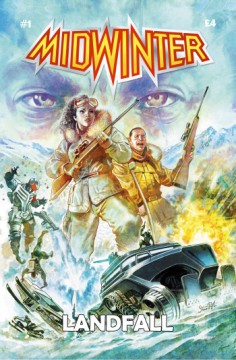“The idea of a vast virtual space was mind blowing” Dan Whitehead on why 80s video game Midwinter was perfect for turning into a comic book
 Comics based on video games have a varied track record, for every Sonic The Comic, there are a dozen lazy cash ins. Fortunately, video game journalist Dan Whitehead has avoided some of those perils by picking an obscure ‘classic’ from the late 1980s for his comic book Midwinter and turned it into a smart survivalist thriller. We catch up with him to find out why Midwinter was so far ahead of it’s time!
Comics based on video games have a varied track record, for every Sonic The Comic, there are a dozen lazy cash ins. Fortunately, video game journalist Dan Whitehead has avoided some of those perils by picking an obscure ‘classic’ from the late 1980s for his comic book Midwinter and turned it into a smart survivalist thriller. We catch up with him to find out why Midwinter was so far ahead of it’s time!

Midwinter is based on a 90s video game is that right? So what was it about that game which made you want to turn it into a comic? Can you tell us a bit about the game and what made it so appealing to convert?
Dan Whitehead: Midwinter was a game from 1989, originally for the Commodore Amiga, developed by an 8-bit genius called Mike Singleton who sadly passed away in 2012. It was one of my favourite games as a teenager. We kind of take it for granted today that you have games where you can go anywhere in 3D worlds, but at the time Midwinter was made it was still mostly 2D platform games and the like. The idea of a vast virtual space – this enormous frozen island with landmarks and little towns, mountains and forests – was mindblowing. But it was also a game about finding people and recruiting them, and to do that you had to understand their character. It was a unique mix of a game with lots of backstory but the actual narrative was entirely driven by what you did rather than what you were told, which to me is the best kind of videogame story.
I wrote a retrospective on the game for Eurogamer about five years ago, and through that found myself in contact with people who were working with Mike Singleton on updating his games for mobile and new consoles, and we kicked around the idea of a remake of Midwinter. As a writer, my contributions at the early stages were limited – it was all about tackling the technical hurdles – so I decided to channel my energies into exploring the same world in a comic.
Tell us a bit about the back story, was this all part of the original concept for the game?
DW: The game didn’t really have a story, at least in the sense that there were no story scenes or a plot to follow. You just had to roam this icy wasteland, recruiting people to your cause to fight back, guerilla-style, against a despotic dictator called General Masters. I toyed with the idea of telling a story about that, but each time you played you were creating a new story of how that fight would go, and I didn’t want to impose a rigid “this is the real story” spin-off on top of people’s experiences and memories of the game. Mike had also written a fairly exhaustive Midwinter novella, which was included in the original instruction booklet. It’s full of memos and research about climate change, and describes the impact of the asteroid that causes the Earth to freeze, and then explains how different people came to the island of Midwinter to start over. It’s really detailed, and superb backstory for a game, but structurally it was very hard to break down. More than that, I felt weird rewriting Mike’s work for my own ends. I felt that should be left to stand.

What I did find was that General Masters, the villain of the game, is only mentioned right at the very end of the novella, almost a throwaway line about this mysterious figure causing problems elsewhere on the island. I realised that this was the gap into which a new story could be told, without interfering with the novella or the player’s own experiences. Once I knew it was going to be the story of how Masters invaded and conquered the island, the pieces fell into place quite quickly. I knew I wanted a young protagonist, someone who hadn’t known any other life, and I knew that the story would be a sort of survivalist coming-of-age tale as they had to flee their invaded home to warn the rest of the island – a sort of frozen version of Paul Revere. I also quite liked the idea of maybe suggesting that General Masters might have had a point. The island runs on geothermal energy, but the rest of the world is never mentioned in the game. I wanted to look at the idea that Midwinter, with its simple but rugged agrarian lifestyle, might actually be the most comfortable and privileged place on this new frozen planet, and that its inhabitants lack of interest in the world beyond their coastline was rather selfish. Given today’s issues with energy and migration, that felt like just enough subtext to keep things interesting.
Did you have to create any new characters for this comic version?
DW: None of the main characters from the comic is in the game. We start in a village called Singleton Point, which is at the very tip of the island. It’s where people go to get away from the slowly evolving communities elsewhere. Our main character is Cassie, she’s a headstrong young woman who wants to get out and explore, but her father, Bryce, was injured while working for the island’s rudimentary police force, and Cassie’s mother was killed. So now he’s a bit too over-protective, tries to steer Cassie towards intellectual pursuits. When the invasion force occupies their village, it’s Cassie who has to escape and inform John Stark – the leader of the Free Villages Police and the main character of the game – what’s coming his way.

As for the characters, none of the main characters from the comic is in the game. We start in a village called Singleton Point, which is at the very tip of the island. It’s where people go to get away from the slowly evolving communities elsewhere. Our main character is Cassie, she’s a headstrong young woman who wants to get out and explore, but her father, Bryce, was injured while working for the island’s rudimentary police force, and Cassie’s mother was killed. So now he’s a bit too over-protective, tries to steer Cassie towards intellectual pursuits. When the invasion force occupies their village, it’s Cassie who has to escape and inform John Stark – the leader of the Free Villages Police and the main character of the game – what’s coming his way.
Did you have any problems with the original games publishers when it came to getting it published?
DW: The original publisher has long since been absorbed into other companies, which were in turn taken over and absorbed into even bigger companies. Thankfully, Mike retained the ownership of his games so it was just a question of getting permission from his family to expand on the Midwinter story. They were totally up for that, and have been really supportive from the first look at the script to the final lettered pages.
How long a story have you got planned out, or will it just be a short run?
DW: I have a story planned out for this first arc, called Landfall. If that proves successful then it’s a big island, full of characters – there are plenty of other stories that could be told.
You have artwork from the super talented PJ Holden, how did you get him involved and do feel his involvement adds an extra element to the book?

DW: Even though this is a totally indie production, entirely self-funded, I knew I wanted it to look and feel like a professional book. I’d worked with Steve Pugh on Nevermore back in 2007, and he was kind enough to accept a commission for a cover image right at the start. I wanted a sort of Bond movie feel to it, or a throwback to the classic Drew Struzan posters, and Steve absolutely knocked it out of the park. That image, which is now the front cover, was my inspiration as I developed the script. For the interior art, I knew quite a lot of comic pros from my previous work, and asked around for recommendations. PJ’s name came up multiple times, and I was a huge fan of his work on Judge Dredd, and I was lucky enough that he wanted to do it when I pitched it to him. When I was writing the script, one inspiration that kept coming back to me was the adventure comics I read as a kid in things like Eagle, Action and Victor, and PJ’s art struck me as a modern evolution of that storytelling style. Wonderful crisp, dynamic lines but with a pulp energy that really suited the story.
And finally if you could convert any other classic video games into comics, which would you choose?
DW: I tend to be drawn to the games that didn’t already have an overt story, as it seems to me that those are the ones the benefit most from being explored in another medium. One that I’d love to play around with is Ant Attack – a game from the prehistoric era of 1983 where you had to explore a creepy and abandoned solid 3D city to save your loved one from giant ants. I think you could have a lot of fun with that as a premise, though it would probably work best as an atmospheric one-shot rather than an ongoing series. Another one would be Mercenary – another 80s game! – that had you stranded on an alien planet, forced to play two opposing forces off against each other in order to escape. It was another open-ended game, and it had a sort of Stainless Steel Rat satirical edge to it. In one of the sequels you could actually win by running for political office. That’s always felt like an idea ripe with potential – what if Han Solo ran for President?
You can purchase Midwinter from Comicsy £4.00 and you can also purchase Dan’s other 80s video game inspired tale Hexloader from Comicsy for £4.00 as well


